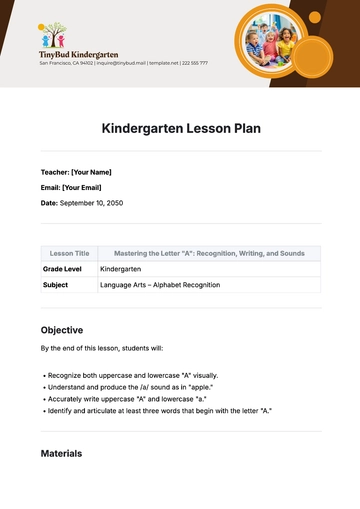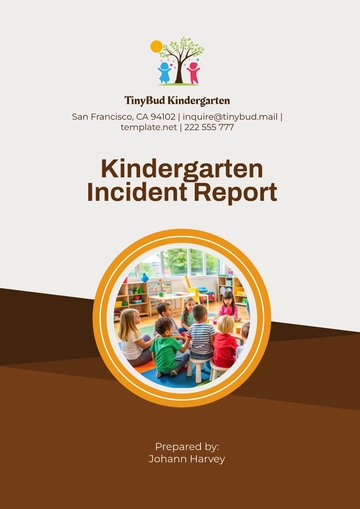Free Kindergarten Curriculum

1. Introduction
Kindergarten is a pivotal stage in a child’s educational journey. It acts as a bridge between early childhood and formal schooling, providing children with essential skills and experiences that form the foundation of their academic and personal development. At [Your Company Name], we understand that the world in 2050 demands a forward-thinking approach to education—one that seamlessly integrates innovative technologies with timeless values such as creativity, collaboration, and compassion.
Our curriculum is specifically designed to cater to the needs of young learners in this era of rapid technological and societal evolution. By blending cutting-edge tools such as artificial intelligence (AI), augmented reality (AR), and robotics with experiential, play-based learning, we ensure that children develop critical cognitive, emotional, and physical skills while fostering a genuine love for learning.
Furthermore, our Kindergarten Curriculum emphasizes the holistic growth of every child. We prioritize creating an inclusive environment where diversity is celebrated, individual strengths are nurtured, and all children feel safe and empowered to explore their potential. Through carefully crafted activities, consistent assessments, and meaningful parent-teacher collaboration, we aim to build a strong foundation that supports lifelong success.
2. Curriculum Overview
The Kindergarten Curriculum for 2050 at [Your Company Name] is designed around six interconnected domains that encompass the core areas of a child’s development. Each domain is thoughtfully integrated into daily activities, ensuring a well-rounded education that prepares children for the complexities of the future while respecting their natural curiosity and need for play.
2.1 Key Features
Interdisciplinary Learning: Children engage in activities that combine multiple domains, such as learning math concepts through stories or exploring science topics through art. This approach fosters deeper understanding and engagement.
Child-Centered Approach: Activities are flexible and responsive to the unique needs, interests, and developmental stages of each child, ensuring personalized growth.
Technology Integration: Tools like coding robots, digital storybooks, and AR learning platforms are used to create interactive and immersive experiences that enhance traditional teaching methods.
Global and Environmental Awareness: The curriculum includes activities that teach children about sustainability, global cultures, and social responsibility, shaping them into thoughtful citizens.
Focus on Emotional Intelligence: Skills such as empathy, self-regulation, and teamwork are emphasized, helping children build positive relationships and navigate social situations effectively.
2.2 Age-Appropriate Milestones
Our curriculum ensures that children achieve key developmental milestones by the end of the kindergarten year. These milestones include:
Recognizing and writing all [26] letters of the alphabet, both uppercase and lowercase, with proper formation.
Counting to [100] confidently, understanding number sequences, and solving simple addition and subtraction problems.
Demonstrating curiosity and observation skills through participation in simple science experiments and exploration activities.
Building social skills by collaborating with peers, resolving conflicts, and taking turns during group activities.
Developing fine motor skills, such as proper pencil grip, and gross motor skills, like hopping, skipping, and balancing.
3. Core Domains and Objectives
3.1 Language and Literacy
Language and literacy skills are critical to a child’s ability to communicate, comprehend, and connect with the world around them. This domain emphasizes early reading, writing, listening, and speaking skills, providing children with the tools they need to express themselves effectively.
3.1.1 Objectives
To introduce children to phonemic awareness, enabling them to recognize letter sounds and blend them into simple words.
To encourage verbal expression through storytelling, show-and-tell activities, and group discussions.
To develop early writing skills, starting with letter tracing and gradually progressing to forming words and short sentences.
To instill a love for books and reading through exposure to diverse genres, including digital storybooks, interactive e-books, and traditional picture books.
3.1.2 Expanded Activities
Daily Phonics Drills: Children practice identifying and pronouncing letter sounds through games and songs, solidifying their phonemic awareness.
Creative Storytelling: Teachers encourage children to create their own stories, using visual prompts or AR tools that animate their ideas.
Word Walls: Each classroom features a wall displaying high-frequency words, which children are encouraged to use in their writing and conversations.
Interactive Read-Alouds: Teachers use projection screens or virtual reality to bring stories to life, engaging children in discussions about characters, settings, and morals.
3.1.3 Assessment Criteria
Recognizing and writing [26] letters of the alphabet.
Reading and understanding simple three- to five-word sentences.
Retelling a story with accurate sequencing of events.
Demonstrating verbal expression by answering questions and participating in group discussions.
3.2 Mathematics
Mathematics at the kindergarten level focuses on developing early numeracy skills, logical reasoning, and problem-solving abilities. By using hands-on activities and visual aids, children learn to see math as an exciting and practical tool for everyday life.
3.2.1 Expanded Objectives
To recognize numbers up to [100] and understand their values through counting, grouping, and comparing.
To solve simple arithmetic problems, such as addition and subtraction within [20], using visual aids and manipulatives.
To explore geometric shapes, patterns, and measurements, laying the groundwork for spatial reasoning.
To introduce basic data representation concepts, such as tally marks, bar graphs, and pictograms.
3.2.2 Enhanced Activities
Counting Collections: Children count and group objects like buttons, beads, or digital items on AR tablets, reinforcing number sense.
Shape Creation: Using materials like playdough, blocks, or holographic tools, children construct shapes and explore their properties.
Pattern Detectives: Children identify and create patterns using everyday items, encouraging critical thinking.
Graphing Favorites: Children collect data on topics like favorite colors or fruits and represent their findings in charts or graphs.
3.2.3 Role of Technology
AR and interactive apps enhance learning by visualizing abstract concepts. For instance, children can manipulate virtual objects to solve math problems or visualize 3D shapes.
3.3 Science and Technology
Science and technology activities encourage curiosity, experimentation, and a deeper understanding of the world. This domain introduces basic scientific principles while leveraging technology to expand learning opportunities.
3.3.1 Expanded Objectives
To nurture a sense of wonder by exploring topics such as weather, plants, animals, and simple physics.
To introduce foundational coding concepts, such as sequencing and problem-solving.
To promote environmental stewardship through hands-on activities like recycling, composting, and gardening.
3.3.2 Featured Activities
Weather Watchers: Children observe weather changes daily, record data, and discuss patterns, linking science with real-life experiences.
Simple Experiments: Activities like mixing baking soda and vinegar or observing plant growth teach cause-and-effect relationships.
Coding Basics: Children use robots and interactive apps to complete coding challenges, developing critical thinking skills.
Sustainability Projects: Teachers guide children in creating eco-friendly crafts or planting classroom gardens, emphasizing the importance of protecting the planet.
3.4 Social and Emotional Development
This domain focuses on building emotional intelligence and interpersonal skills, essential for positive relationships and personal growth.
3.4.1 Expanded Objectives
To help children recognize and regulate their emotions, building resilience and self-awareness.
To foster empathy and respect through collaborative activities and role-playing.
To teach conflict-resolution strategies, empowering children to navigate disagreements peacefully.
3.4.2 Enhanced Strategies
Emotion Cards: Children use cards to identify their feelings, promoting emotional literacy.
Kindness Journals: Children record acts of kindness they observe or perform, encouraging a culture of gratitude and compassion.
Team Challenges: Group activities like building towers or solving puzzles promote cooperation and teamwork.
3.5 Physical Development and Well-being
Physical development is critical for motor skill refinement, health, and overall well-being. This domain combines structured activities with free play, ensuring children remain active and engaged.
3.5.1 Expanded Objectives
To improve gross motor skills through activities like running, jumping, and climbing.
To refine fine motor skills through tasks like cutting, drawing, and building.
To promote mental well-being through relaxation techniques such as mindfulness and yoga.
3.5.2 Activities and Tools
Movement Circuits: Children participate in obstacle courses designed to challenge balance, coordination, and agility.
Craft Corners: Fine motor skills are developed through cutting, folding, and crafting.
Mindfulness Moments: Daily breathing exercises and mindfulness sessions help children develop focus and calmness.
3.6 Creative Arts
The creative arts allow children to express themselves, explore their imagination, and appreciate the diversity of human culture.
3.6.1 Expanded Objectives
To inspire creativity and self-expression through visual arts, music, dance, and drama.
To develop collaborative skills through group art projects and performances.
To expose children to diverse art forms, fostering cultural appreciation and open-mindedness.
3.6.2 Expanded Activities
Art Exploration: Children experiment with different materials and techniques, such as painting with natural dyes or sculpting with clay.
Music Makers: Using instruments and digital tools, children create and record original music pieces.
Story Theater: Teachers guide children in acting out stories, building confidence and communication skills.
4. Daily Schedule
The daily schedule is carefully designed to maintain a dynamic balance between structured learning, free play, and rest, ensuring that children remain engaged, supported, and energized throughout the day. This schedule allows flexibility to accommodate individual learning paces and group activities while also promoting consistency, which is essential for young learners.
4.1 Detailed Schedule Breakdown
Time | Activity | Domain(s) Involved | Focus Areas |
|---|---|---|---|
[8:00 AM] | Arrival and Morning Greeting | Social and Emotional | Building connections, feeling secure. |
[8:15 AM] | Circle Time | Emotional and Social | Sharing, group mindfulness activities. |
[8:45 AM] | Literacy Activities | Language and Literacy | Phonics, storytelling, reading. |
[9:15 AM] | Math Exploration | Mathematics | Numbers, patterns, problem-solving. |
[10:00 AM] | Snack Break | Physical Well-being | Healthy eating habits. |
[10:30 AM] | Outdoor Play | Physical Development | Gross motor skills, coordination. |
[11:00 AM] | Creative Arts | Visual Arts, Music, Drama | Creativity, cultural appreciation. |
[11:30 AM] | Science and Technology | Science and Technology | Experiments, coding, exploration. |
[12:00 PM] | Lunch | Physical and Social | Nutrition, social interactions. |
[12:45 PM] | Quiet Time | Emotional and Physical | Rest, mindfulness, individual focus. |
[1:15 PM] | Thematic Activities | Interdisciplinary Learning | Integrated projects on weekly themes. |
[1:45 PM] | Closing Circle and Dismissal | Emotional and Social | Reflecting on the day, building closure. |
4.2 Expanded Explanation of Activities
4.2.1 Morning Greeting and Arrival
The day begins with a welcoming environment where children are greeted warmly by teachers and peers. This initial interaction establishes a sense of security and sets a positive tone for the day. Children are encouraged to place their belongings in designated areas independently, fostering organizational skills and responsibility. Teachers also use this time to engage in brief one-on-one conversations with each child, ensuring they feel seen and valued.
4.2.2 Circle Time
During circle time, children gather in a shared space to participate in group activities such as singing songs, reciting rhymes, or discussing the day's themes. This activity helps children build a sense of community, practice turn-taking, and develop listening skills. Mindfulness exercises, such as guided breathing or storytelling, are incorporated to promote emotional regulation and focus. Teachers also use this time to introduce new concepts or review previous lessons.
4.2.3 Literacy Activities
Literacy activities include interactive storytelling, phonics games, and letter recognition exercises. Teachers encourage children to share their thoughts about stories, enhancing comprehension and verbal expression. Hands-on activities like tracing letters or creating word collages help reinforce literacy concepts in a tactile manner.
4.2.4 Math Exploration
Math exploration involves practical, engaging activities such as counting objects, identifying patterns, and solving simple puzzles. For example, children might use blocks to build towers of specific heights, practicing addition and subtraction in the process. Incorporating everyday objects like fruits or toys makes math relatable and fun.
4.2.5 Outdoor Play
Outdoor play is essential for physical development and social interaction. Activities include running, climbing, or engaging in group games like tag or relay races. Teachers supervise and guide children to ensure safety while encouraging cooperative play and problem-solving. Nature-based activities, such as gardening or exploring natural materials, help children connect with the environment.
4.2.6 Thematic Activities
Themes like “Under the Sea” or “Space Adventures” integrate various subjects into a cohesive learning experience. For instance, during an ocean-themed week, children might learn about marine animals in science, create underwater murals in art, and count seashells during math time. This interdisciplinary approach encourages curiosity and helps children draw connections between different areas of learning.
5. Teacher Guidelines
Teachers at [Your Company Name] play a pivotal role in fostering a positive, inclusive, and stimulating learning environment. They are equipped with resources, strategies, and ongoing support to ensure every child reaches their full potential.
5.1 Professional Development
5.1.1 Continuous Training
To remain at the forefront of early childhood education, teachers attend bi-monthly professional development workshops. These sessions cover topics like adaptive teaching strategies, integrating technology in classrooms, and fostering emotional resilience in children. Teachers are also encouraged to participate in international conferences to gain insights from global educational practices.
5.1.2 Technology Proficiency
Educators are trained to seamlessly integrate technology into their teaching. This includes using augmented reality (AR) tools for interactive storytelling, coding robots for problem-solving activities, and digital platforms for monitoring children’s progress. Training ensures that teachers are confident and effective in leveraging these tools to enhance learning experiences.
5.1.3 Cultural Sensitivity
Creating an inclusive classroom environment is a priority at [Your Company Name]. Teachers undergo training on cultural sensitivity, enabling them to celebrate diversity and address the unique needs of every child. Activities and materials are designed to reflect a range of cultures, ensuring all children feel represented and valued.
5.2 Classroom Management
5.2.1 Positive Reinforcement
Teachers use positive reinforcement techniques to encourage desirable behaviors and build children’s self-esteem. This may include verbal praise, reward systems like sticker charts, or classroom celebrations of achievements. Positive reinforcement fosters a sense of accomplishment and motivates children to engage actively in learning.
5.2.2 Flexible Schedules
Recognizing that children have varying energy levels and attention spans, teachers are encouraged to adapt the timing and pacing of activities. For instance, if children are particularly restless during an indoor activity, the schedule can shift to include more outdoor play or movement-based learning.
5.2.3 Behavioral Support
Teachers receive specialized training to address common behavioral challenges, such as difficulty sharing, managing frustration, or handling transitions. Strategies include role-playing, visual aids, and calming techniques like breathing exercises. These approaches help children develop emotional regulation and social skills.
5.3 Parent Collaboration
Building strong partnerships with parents is fundamental to a child’s success. Teachers work closely with families to create a collaborative approach to education.
5.3.1 Parent-Teacher Conferences
Regularly scheduled conferences provide an opportunity to discuss a child’s progress, celebrate achievements, and set goals. Teachers share specific examples of the child’s work and behavior, offering a clear picture of their development.
5.3.2 Classroom Portfolios
Parents receive access to a comprehensive portfolio showcasing their child’s projects, artwork, and photographs of classroom activities. These portfolios serve as a tangible record of progress and a tool for celebrating milestones.
5.3.3 Workshops for Parents
Parent workshops cover topics like creating effective learning environments at home, managing screen time, and fostering resilience in children. These sessions equip parents with practical strategies to support their child’s development outside of the classroom.
6. Assessment and Evaluation
Assessment is an integral part of the kindergarten curriculum at [Your Company Name], providing insights into a child’s progress and informing individualized learning strategies. The focus is on growth and development rather than competition, ensuring every child feels supported and encouraged.
6.1 Methods of Assessment
6.1.1 Observation
Observation is a continuous process where teachers note behaviors, interactions, and achievements during daily activities. For example, a teacher might document a child’s problem-solving approach during a building activity or their ability to cooperate with peers during group play.
6.1.2 Portfolios
Each child’s portfolio includes work samples, photographs of activities, and teacher notes. These portfolios serve as a narrative of the child’s learning journey, highlighting their strengths and areas for growth. Portfolios are also shared with parents during conferences, fostering a collaborative approach to development.
6.1.3 Checklists and Milestone Trackers
Developmental checklists help teachers track progress in key areas like fine motor skills, language development, and social interactions. These tools ensure that children meet age-appropriate milestones and receive targeted support when needed.
6.1.4 Digital Assessments
Interactive digital platforms provide real-time feedback on skills like numeracy and literacy. These tools adapt to each child’s level, ensuring they are appropriately challenged and supported. Data from digital assessments is used to tailor instruction to individual needs.
6.2 Frequency of Assessment
Assessment is a continuous process, with multiple touchpoints throughout the year:
Daily: Informal observations during activities provide immediate feedback.
Monthly: Milestone trackers are updated to monitor progress.
Quarterly: Formal assessments are conducted, and detailed reports are shared with parents.
6.3 Reporting
6.3.1 Progress Reports
Progress reports provide a detailed overview of a child’s achievements, challenges, and goals. These reports cover both academic and non-academic domains, offering a holistic view of development.
6.3.2 Parent Communication
Teachers share assessment insights through one-on-one meetings, digital updates, and newsletters. This ensures parents are consistently informed and involved in their child’s education.
6.3.3 Celebrating Achievements
Children’s achievements are celebrated through certificates, classroom displays, and special events. For example, a “Math Mastery Day” might recognize children who have made significant progress in numeracy.
- 100% Customizable, free editor
- Access 1 Million+ Templates, photo’s & graphics
- Download or share as a template
- Click and replace photos, graphics, text, backgrounds
- Resize, crop, AI write & more
- Access advanced editor
Plan and structure effective learning programs with the Kindergarten Curriculum Template from Template.net. Designed for flexibility and customization, this template helps educators outline clear, age-appropriate learning objectives.





























